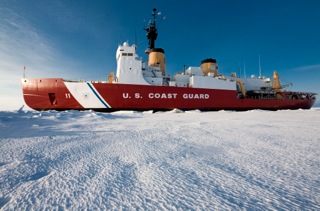Years of reduced funding have slowed the Coast Guard’s shipbuilding program to the point that those cutbacks are actually costing taxpayers more money in the long run, officials from the Coast Guard and General Accounting Office told members of Congress in a May 14 hearing on Capitol Hill.
In the short term, the Coast Guard is getting ships delivered on time and budget, but “the problem is, what’s the baseline?” said Rear Adm. Bruce Baffer, the Coast Guard’s assistant commandant for acquisitions. “That lack of predictable funding increases costs.”
The Coast Guard has been working to recapitalize its fleet in the years since the ill-fated Deepwater program finally collapsed in 2011 after management failures. There have been notable successes, like the now-deployed 418’ National Security Cutter design and the service’s Rescue 21 communications and search and rescue system, Baffer told members of the House Subcommittee on the Coast Guard and Marine Transportation.
Other progress has been slower. The new Offshore Patrol Cutter, intended to replace 270’ and 210’ medium endurance cutters built from the 1960s to the 1980s, is finishing up the preliminary and contract design phase, and the Coast Guard will choose a contractor to execute the final design in 2016, Baffer said. In February 2014, Bollinger Shipyards, Eastern Shipbuilding Group and Bath Iron Works were named finalists for the OPC contract.
To make the new cutters affordable, the Coast Guard is basing its building plan on turning out two OPCs a year for production efficiency, Baffer said. The goal is 25 OPCs at an average cost around $421 million per vessel.
In March, Coast Guard Commandant Adm. Paul Zukunft told the House Appropriations Committee that the service’s FY 2016 budget fell short by $69 million of what’s needed for the OPCs. The program will need to rely on Department of Homeland Security leadership for budget transfers to make up the difference.
Subcommittee chairman Rep. Duncan Hunter said the hearing aimed to identify what spending is needed to get the recapitalization program back on track.
The only way to reverse the decline in the Coast Guard’s mission performance is to make the necessary investments to acquire new and improved assets,” Hunter said in a statement. “Unfortunately, based on the FY 2016 budget request, as well as the FY 2016 through 2020 Capital Investment Plan, it appears the President refuses to make those investments.”
“According to the Coast Guard’s Capital Investment Plan, over the next five fiscal years, annual funding for acquisitions never exceeds $1.2 billion. That is approximately $1 billion less than the GAO and the former Commandant of the Coast Guard have testified is needed on an annual basis to keep the current acquisition program on schedule and on budget.”
Subcommittee members on Thursday took particular interest in the Coast Guard’s Arctic icebreaking capabilities. With maritime activity traffic increasing in the high north, the service is considering reactivation of the 399’x83’6”x31’ Polar Sea, now laid up in Seattle, Wash. since 2010.
A Coast Guard analysis has called for three heavy and three medium icebreakers for duty in Arctic and Antarctic waters. “Polar Sea could be a potential bridging” in the years needed to design a build a $1 billion heavy icebreaker project, Baffer said.
“The hull is pretty good,” Baffer said. But the icebreaker built in 1977 needs extensive engineering and equipment modifications to operate at modern environmental standards, which would be an expensive challenge, he said.
The Coast Guard is getting some help to update its air operations, with the planned transfer of 14 C-27J Spartans from the Air Force. The twin-engine medium-range transports were shelved by the Air Force due to budget cuts, and last November the Coast Guard took delivery of the first restored Spartan for training crews at Elizabeth City, N.C.
But it will take several years to restore all the aircraft, “and even with the C-27 the Coast Guard will fall 20 percent short of its flight hours,” said Michele Mackin, director of acquisition and sourcing management form the General Accounting Office.
“What we’d really like to see is a long-term plan for what is needed over 20 years” in ships and aircraft, she said.
Rep. John Garamendi, D-Calif., suggested to price tag for meeting those needs could be “north of $2 billion.”
“An additional billion dollars would seem to be impossible” in this Congress, unless it comes out of other military and social spending, Garamendi said. That could make sense, he added, because “we know the U.S. Navy can’t operate in the Arctic without an icebreaker, yet we have no money for an icebreaker.”




